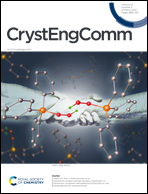Facile synthesis, structure, and tunable luminescence properties of novel one-dimensional Bi4Si3O12 fibers†
Abstract
A series of novel one-dimensional bismuth silicate (Bi4Si3O12) fibers have been synthesized via the electrospinning method followed by a subsequent annealing process for the first time. During the synthesis process, the mass ratio of PVP/PEO additives plays a crucial role for the formation of uniform and well-dispersed fibrous precursors. A PVP/PEO ratio of 1/0.25 is selected for the fabrication of the Bi4Si3O12 product leading to its high uniformity, high output, and easy collection. Well-defined Bi4Si3O12 fibers with a cubic eulytite structure are obtained after a calcination procedure, and inherit the perfect morphology and dispersity of the fibrous precursor. The Ln3+ (Ln = Sm or Dy) doped Bi4Si3O12 fibers exhibit both the intrinsic luminescence of the Bi4Si3O12 host and the characteristic emissions of Ln3+ ions due to insufficient energy transfer from the host to Ln3+. In particular, tunable multicolor emissions of the Sm3+ doped samples are obtained in a single phase from blue through bluish-white and eventually toward pure white emission [chromaticity coordinates: (0.340, 0.330); CCT: 5129 K] by simply adjusting the Sm3+ doping concentrations. The corresponding white light emitting diode (WLED) devices can exhibit bright white light emission by integrating the Bi4Si3O12:10 mol% Sm3+ phosphor into a UV LED chip. Moreover, the Yb3+/Er3+, Yb3+/Ho3+, and Yb3+/Tm3+ doped Bi4Si3O12 fibers exhibit excellent characteristic up-conversion (UC) luminescence properties under 980 nm NIR excitation, which can be confirmed using their UC emission spectra, decay curves, and luminescence photographs. Due to their good crystallinity, uniform fibrous morphology, and eminent down-conversion (DC) and UC luminescence properties, the as-synthesized Ln3+ doped Bi4Si3O12 fibers may find potential applications in the fields of optoelectronic devices and solid state lighting.



 Please wait while we load your content...
Please wait while we load your content...